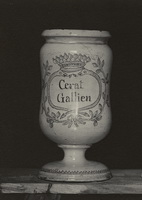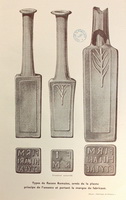
| The King Philippe Arridée giving parfumes to Horus-Ra Egyptian God. Eugène Rimmel. Le livre des parfums. Préface d’Alphonse Karr. Paris, Gand, Leipzig: Dentu, 1870. |
|
This document is freely available
|
| BIU Santé Pharmacie : cote RES 14582. |
|
|

| Eugène Rimmel. Le livre des parfums. Préface d’Alphonse Karr. Paris, Gand, Leipzig : Dentu, 1870. |
| This document is freely available |
| BIU Santé Pharmacie : cote RES 14582. |
|
|

| Galenus Cerate (an ancient Cold Cream). Album de platinotypies of Hyppolite Blancard, given to Dr. Paul Dorveaux, July 21, 1900. |
| |
| © Collection d’histoire de la pharmacie – Conseil national de l'Ordre des pharmaciens. |
|
|

| Roman flaks for cosmetic oils with the name of the ingredient and the brand of the maker. Les Parfums de France, 1936. |
| |
| BIU Santé Pharmacie : cote P 15268. |
|
|